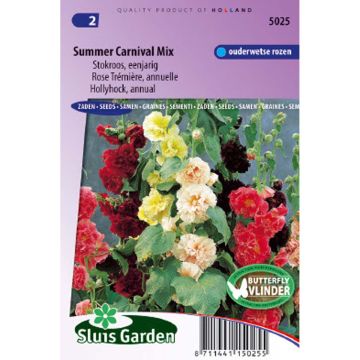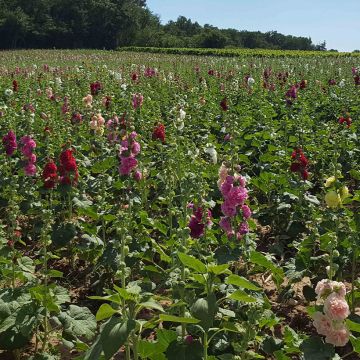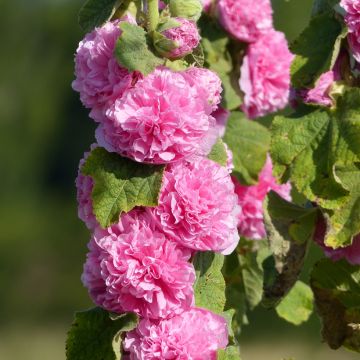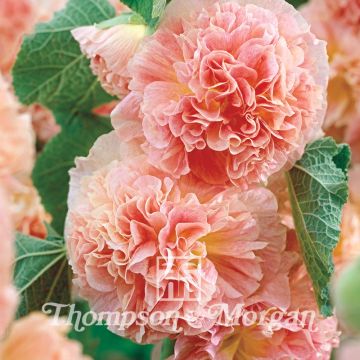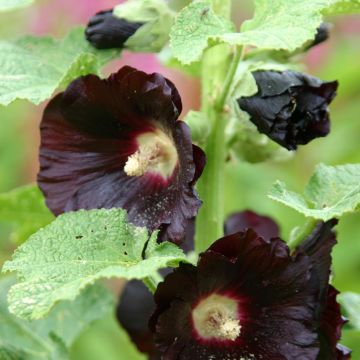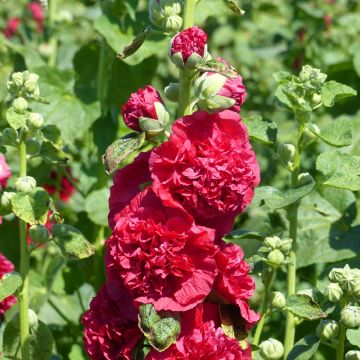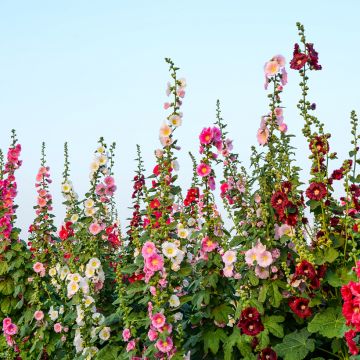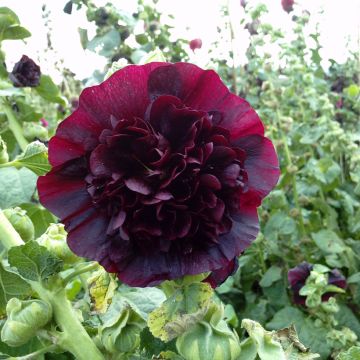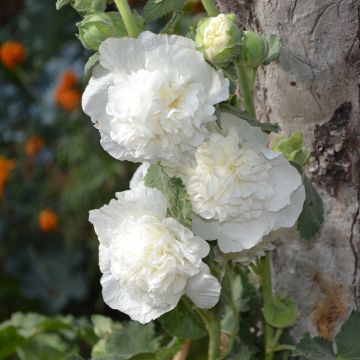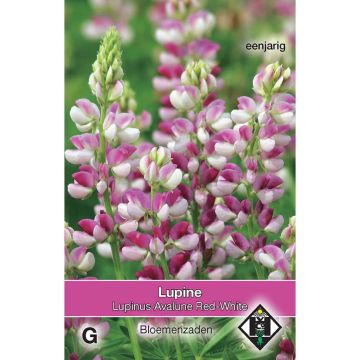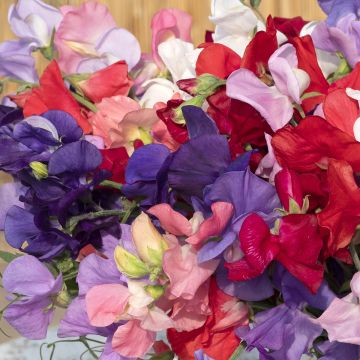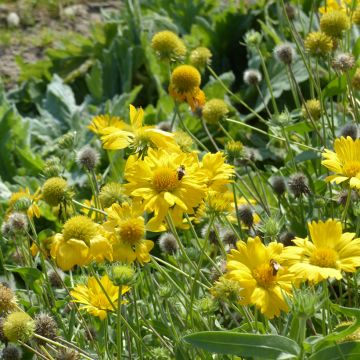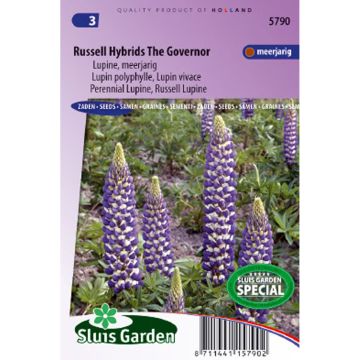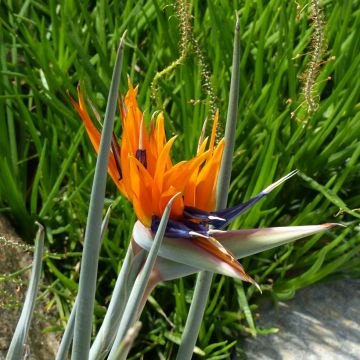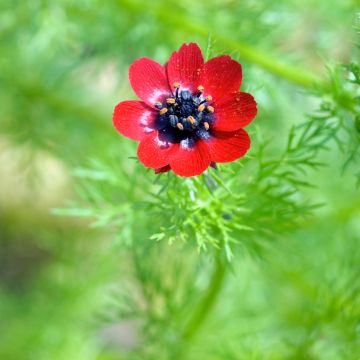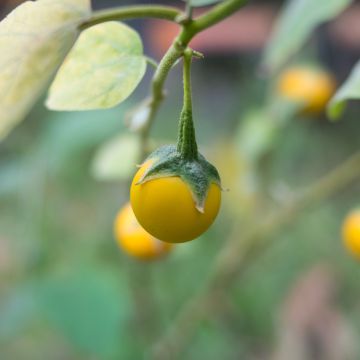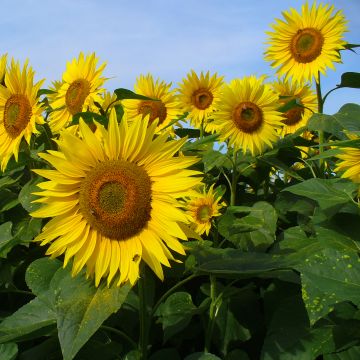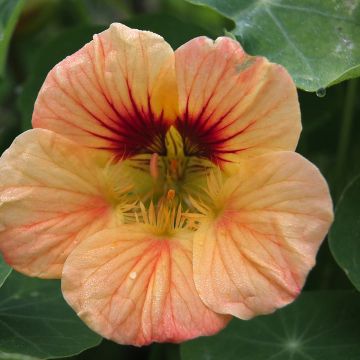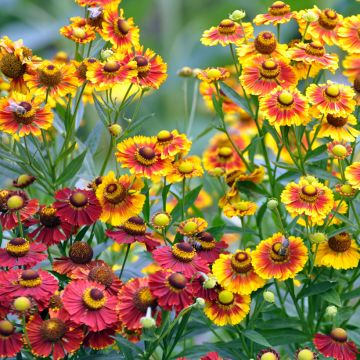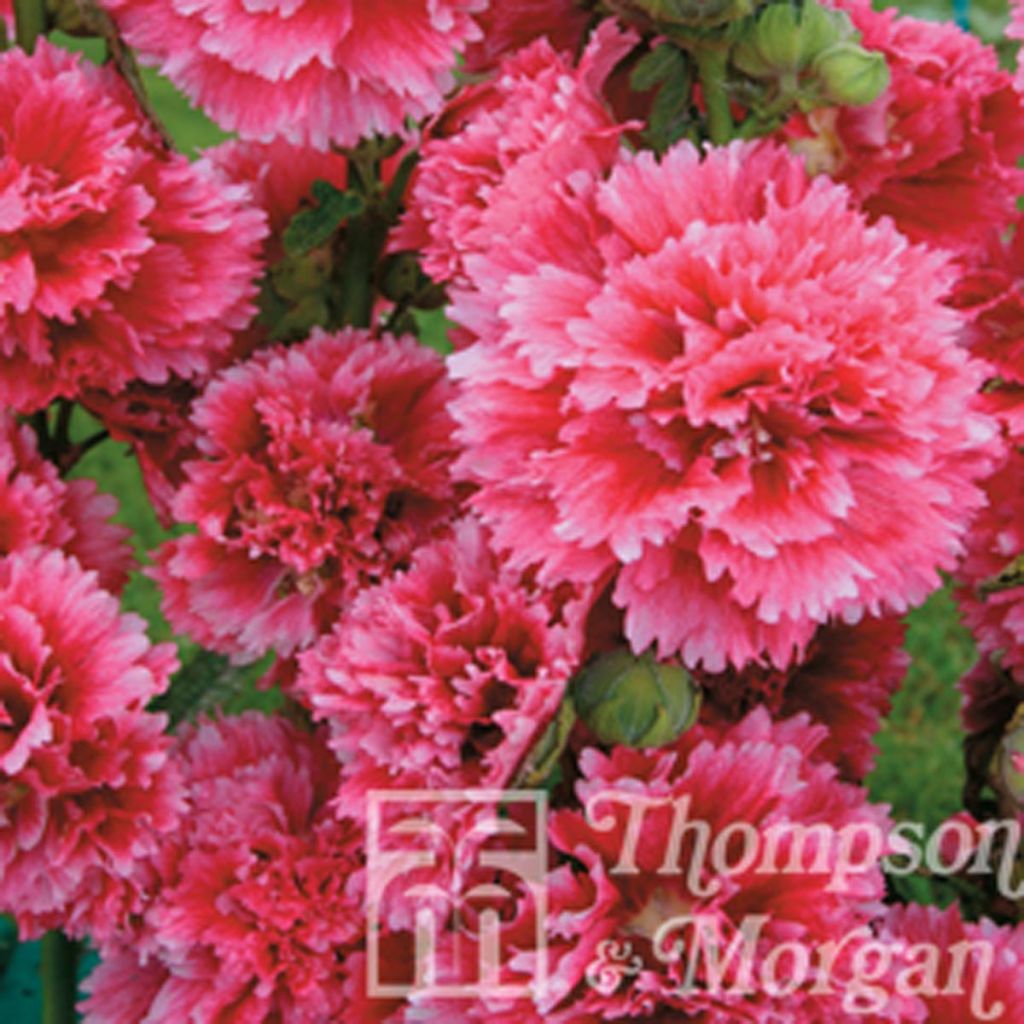

Graines de Rose trémière Fiesta Time - Alcea rosea
Alcea rosea Fiesta Time Seeds - Hollyhock
Alcea rosea Fiesta Time
Hollyhock
Low germination rate after 4 weeks in buckets in the greenhouse: 9/20.
Elisabeth, 19/08/2017
This plant carries a 6 months recovery warranty
More information
We guarantee the quality of our plants for a full growing cycle, and will replace at our expense any plant that fails to recover under normal climatic and planting conditions.
Seed-only orders are dispatched by sealed envelope. The delivery charge for seed-only orders is €3.90.
Does this plant fit my garden?
Set up your Plantfit profile →
Description
Alcea rosea 'Fiesta Time' is a compact variety, capable of flowering in its first year. Its double flowers are cherry-pink to red with white margins. All of these shades combine on fringed petals. This variety blooms for a long time. The flowers appear on rigid and sturdy stems, which are abundantly adorned with buds. A perennial or biennial plant, it is very easy to combine in perennial borders and looks spectacular in large pots. It tolerates ordinary but well-drained soil, even poor, chalky, and rocky soil.
Alcea rosea belongs to the Malvaceae family. It is native to Asia Minor and is often naturalised in wild gardens, fallow lands, and on mounds of earth. 'Fiesta Time' is a shorter variety, with double flowers, derived from this wild plant. It is a compact, well-branched plant that will not exceed 90cm (35in) in height. It forms a rosette of rounded, hairy, and rough leaves, from which a strong floral stem emerges. It has a rapid growth rate. Its spike-shaped inflorescences are covered with large buds that open in a staggered manner from June to August. They bloom from bottom to top, into large, double flowers whose texture beautifully reflects light. They display a cherry-pink to intense red colour, margined with white. The petals are fringed on their periphery. Throughout this period, they will attract bees and butterflies to your garden. The flowering gives way to numerous fruits filled with seeds that self-sow spontaneously in the most unexpected areas: at the foot of walls, in poor and rocky soils, and crevices in walls. Its taproot system makes transplantation difficult, especially in well-developed plants. Direct sowing yields good results.
Widely found in abandoned gardens or fallow land, it is often grown in the back of borders or against a wall that protects it from strong winds. The bright colour and compact habit of this variety will create superb combinations with light perennials such as gauras, perennial flax, damask nigellas, or paniculate baby's breath. You can try taming this 'Fiesta Time' hollyhock in large pots on a patio. This plant is said to be tolerant of juglone, a substance secreted by walnut roots, so you can consider planting this hollyhock at the base of a walnut tree, if there is sufficient light. It is an edible plant; the flower buds can be consumed raw in salads and the young leaves raw or cooked.
It is both ornamental and medicinal. Oil with drying properties is obtained from its seeds. Rich in mucilage, it has soothing, emollient, expectorant, laxative, and appetising properties, albeit attenuated compared to those of its cousin, Althea officinalis.
Report an error about the product description
Flowering
Foliage
Plant habit
Botanical data
Alcea
rosea
Fiesta Time
Malvaceae
Hollyhock
Cultivar or hybrid
Other Hollyhock seeds
Planting and care
Sow the seeds from May to July. It takes 20 to 25 days for the young shoots to appear. Transplant the young plants when they reach a height of 7cm (3in). Plant at a distance of 20cm (8in) from each other. In the following spring, place them in your flower beds at a distance of 40 to 50cm (16 to 20in). Consider staking them if the location is not protected from the wind.
Autumn sowing, directly in place, is possible in regions with mild winters. Hollyhocks do not tolerate severe cold combined with winter humidity. Plants sown using this technique will be more vigorous as their taproot deepens into the soil during winter, making them less sensitive to summer drought. There is mention, in ancient Finnish literature, of perfectly perennial strains that would easily survive colder winters. One thing is certain: there are no longer any wild strains in our regions. The plants that emerge spontaneously in our countryside and gardens all come from horticultural varieties, which are countless and easily hybridise with each other.
These plants appreciate warm situations, sunlight, and can adapt to ordinary soil, even clay, limestone, poor or rocky soil.
Avoid planting hollyhocks in the same spot for several years in a row to prevent the appearance of rust (a parasitic fungus visible as orange powder) on the foliage.
Remove the faded flower stalks in October.
Sowing period
Intended location
-
, onOrder confirmed
Reply from on Promesse de fleurs
Flower seeds
Haven't found what you were looking for?
Hardiness is the lowest winter temperature a plant can endure without suffering serious damage or even dying. However, hardiness is affected by location (a sheltered area, such as a patio), protection (winter cover) and soil type (hardiness is improved by well-drained soil).

Photo Sharing Terms & Conditions
In order to encourage gardeners to interact and share their experiences, Promesse de fleurs offers various media enabling content to be uploaded onto its Site - in particular via the ‘Photo sharing’ module.
The User agrees to refrain from:
- Posting any content that is illegal, prejudicial, insulting, racist, inciteful to hatred, revisionist, contrary to public decency, that infringes on privacy or on the privacy rights of third parties, in particular the publicity rights of persons and goods, intellectual property rights, or the right to privacy.
- Submitting content on behalf of a third party;
- Impersonate the identity of a third party and/or publish any personal information about a third party;
In general, the User undertakes to refrain from any unethical behaviour.
All Content (in particular text, comments, files, images, photos, videos, creative works, etc.), which may be subject to property or intellectual property rights, image or other private rights, shall remain the property of the User, subject to the limited rights granted by the terms of the licence granted by Promesse de fleurs as stated below. Users are at liberty to publish or not to publish such Content on the Site, notably via the ‘Photo Sharing’ facility, and accept that this Content shall be made public and freely accessible, notably on the Internet.
Users further acknowledge, undertake to have ,and guarantee that they hold all necessary rights and permissions to publish such material on the Site, in particular with regard to the legislation in force pertaining to any privacy, property, intellectual property, image, or contractual rights, or rights of any other nature. By publishing such Content on the Site, Users acknowledge accepting full liability as publishers of the Content within the meaning of the law, and grant Promesse de fleurs, free of charge, an inclusive, worldwide licence for the said Content for the entire duration of its publication, including all reproduction, representation, up/downloading, displaying, performing, transmission, and storage rights.
Users also grant permission for their name to be linked to the Content and accept that this link may not always be made available.
By engaging in posting material, Users consent to their Content becoming automatically accessible on the Internet, in particular on other sites and/or blogs and/or web pages of the Promesse de fleurs site, including in particular social pages and the Promesse de fleurs catalogue.
Users may secure the removal of entrusted content free of charge by issuing a simple request via our contact form.
The flowering period indicated on our website applies to countries and regions located in USDA zone 8 (France, the United Kingdom, Ireland, the Netherlands, etc.)
It will vary according to where you live:
- In zones 9 to 10 (Italy, Spain, Greece, etc.), flowering will occur about 2 to 4 weeks earlier.
- In zones 6 to 7 (Germany, Poland, Slovenia, and lower mountainous regions), flowering will be delayed by 2 to 3 weeks.
- In zone 5 (Central Europe, Scandinavia), blooming will be delayed by 3 to 5 weeks.
In temperate climates, pruning of spring-flowering shrubs (forsythia, spireas, etc.) should be done just after flowering.
Pruning of summer-flowering shrubs (Indian Lilac, Perovskia, etc.) can be done in winter or spring.
In cold regions as well as with frost-sensitive plants, avoid pruning too early when severe frosts may still occur.
The planting period indicated on our website applies to countries and regions located in USDA zone 8 (France, United Kingdom, Ireland, Netherlands).
It will vary according to where you live:
- In Mediterranean zones (Marseille, Madrid, Milan, etc.), autumn and winter are the best planting periods.
- In continental zones (Strasbourg, Munich, Vienna, etc.), delay planting by 2 to 3 weeks in spring and bring it forward by 2 to 4 weeks in autumn.
- In mountainous regions (the Alps, Pyrenees, Carpathians, etc.), it is best to plant in late spring (May-June) or late summer (August-September).
The harvesting period indicated on our website applies to countries and regions in USDA zone 8 (France, England, Ireland, the Netherlands).
In colder areas (Scandinavia, Poland, Austria...) fruit and vegetable harvests are likely to be delayed by 3-4 weeks.
In warmer areas (Italy, Spain, Greece, etc.), harvesting will probably take place earlier, depending on weather conditions.
The sowing periods indicated on our website apply to countries and regions within USDA Zone 8 (France, UK, Ireland, Netherlands).
In colder areas (Scandinavia, Poland, Austria...), delay any outdoor sowing by 3-4 weeks, or sow under glass.
In warmer climes (Italy, Spain, Greece, etc.), bring outdoor sowing forward by a few weeks.

































